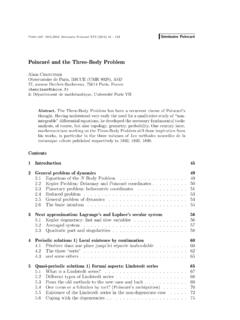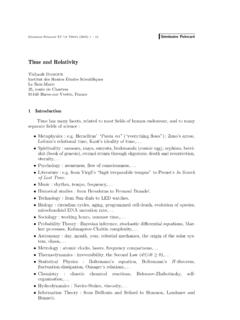Transcription of Magnetic Resonance Imaging: From Spin Physics …
1 Quantum Spaces, 1 35c 2008 Birkh auser Verlag Basel, 2007 Poincar e Seminar 2007 Magnetic Resonance Imaging: From spin Physics to Medical DiagnosisPierre-Jean rather similar historical evolutions are evoked, each one orig-inating in fundamental spin studies by physicists, and ending as magneticresonance imaging (MRI), a set of invaluable tools for clinical diagnosis in thehands of medical doctors. The first one starts with the early work on nuclearmagnetic Resonance , the founding stone of the usual proton-based MRI, ofwhich the basic principles are described. The second one starts with the op-tical pumping developments made to study the effects of spin polarization invarious fundamental problems. Its unexpected outcome is a unique imagingmodality, also based on MRI, for the study of lung physiology and Historical introductionMagnetic Resonance imaging (MRI), now widely known for its usefulness as amedical diagnosis tool and for the variety of clear pictures of the body s interiorobtained in a harmless and non-invasive manner, had its foundations laid morethan 60 years ago in Physics experiments designed to measure properties of thenuclear spins of hydrogen atoms.
2 In even earlier experiments, Rabi had shown thatan oscillating Magnetic field could induce transitions between levels associated tothe spin state of various nuclei in an applied static Magnetic field [1]. This pio-neering work was performed on molecular beams, using a selection and detectionmethod of the nuclear spin state similar to that developed in the 1920 s by Sternand Gerlach for their demonstration of spin quantification in silver atoms. Thetransposition of Rabi s observation of Nuclear Magnetic Resonance (NMR) in abeam of independent molecules to solid and liquid samples was successfully doneindependently in 1945 by Purcell and by key feature of both experi-ments was the observation of the Resonance phenomenon through electromagnetic1An earlier attempt in Leiden to observe NMR in solids had failed because of exceptionally longrelaxation times [9].
3 Gorter first used the term nuclear Magnetic Resonance in this publication, Nacherdetection at the Resonance frequency. At the ,2 Purcell, Torrey, and Pound,worked on solid paraffin filling a 1-liter cavity tuned at 30 MHz. They observed change in the rf signal amplitude fed to the cavity due to energy dissipationarising from nuclear spin relaxation of H atoms [2]. Meanwhile, at Stanford Uni-versity, Bloch, Hansen, and Packard, performed similar experiments at MHzon a sample of water. They used two orthogonal rf coils: the receive coil de-tected the re-emission of the resonant rf power absorbed from the transmit coil bythe nuclei of the water protons (H atoms) [3, 4]. Although Rabi s work was crucialas the initial demonstration of NMR (he was awarded the Physics Nobel prize in1944 for his Resonance method for recording the Magnetic properties of atomicnuclei ), the conceptual and technical leap achieved by Bloch and Purcell reallyopened the way to modern NMR and MRI.
4 They were awarded the 1952 PhysicsNobel prize for their development of new methods for nuclear Magnetic precisionmeasurements and discoveries in connection therewith . A last essential tool ofNMR was found independently by Torrey [5] and Hahn [6], who demonstrated thefeasibility of pulsed NMR (initially suggested by Bloch) and observed free Larmorprecession. Hahn further used pulsed NMR to generate and observe spin echoes [7].The next 20 years saw the development of NMR as a powerful investigativetool in many areas of Physics and even more so in chemistry. The sensitivity of thenucleus to its electronic environment in a molecule (the chemical shift ) and spin - spin interactions were seen at first in the nuclear Physics community as annoyingfeatures, but the potential of NMR spectroscopy for analytical studies was soonrevealed by the discovery of the 3 peaks of ethanol in Purcell s group [8].
5 Almostnone of the early applications of NMR were medical, although a large amount ofwork was published on relaxation, diffusion, and exchange of water in cells andtissues, even in living human subjects [10] and whole animals [11].However it was not until 1973 that NMR was used to generate true (2-D) im-ages, when Lauterbur, after his early work on chemical shifts, produced images (oftwo glass tubes filled with water) reconstructed from a series of 1-D projectionsobtained using a Magnetic field gradient [12]. Soon, MRI benefited from essen-tial developments performed by Mansfield in Nottingham to efficiently generateimages, such as slice selection [13] and fast acquisition schemes [14]. These pio-neering contributions were jointly rewarded by the 2003 Nobel prize in Medicine for their discoveries concerning Magnetic Resonance imaging .
6 Another essentialcontribution to MRI originated from Zurich, where Ernst applied his Fourier spec-troscopy techniques [15] to imaging [16] (Ernst was awarded the Nobel Prize inattributing the coining of the expression to Rabi. In Kazan, another place where major contri-butions to NMR were made, Zavoiskii had also failed to reliably detect NMR in 1941, but hediscovered electron spin Resonance (EPR) in obtained his PhD degree in 1938 at Havard University, where he returned in 1945,became Professor of Physics in 1949, and performed most of his work. But he spent the war yearsin the Fundamental Developments Group in the Radiation Laboratory of the , where hewas associated in particular to Rabi. Purcell s seminal publication on NMR [2] bears the : From spin Physics to Medical Diagnosis3 Chemistry in 1991 for his contributions to the development of the methodologyof high resolution nuclear Magnetic Resonance spectroscopy ).
7 Research in MRI was pursued only in a few academic laboratories, mostly inthe UK, with the first image of a human thorax in 1977, of a head in 1978, until1980 when Edelstein, in Mallard s team in Aberdeen, obtained the first clinicallyuseful image of a patient [17]. After this date, several companies started to invest inMRI developments and to promote clinical trials. For instance, Toshiba marketedthe first commercial MRI scanner in 1983 (with a T field), while GeneralElectric, the current leading manufacturer, enrolled several of the MRI pioneers,including Edelstein, and produced the first T clinical system in 1985. With thegrowing availability and performance of MRI instruments, scientific publicationson MRI in medical journals linearly increased in number from 1984, to reach 16000per year in 2006 [18].
8 At the same time, MRI exams progressively became a routinediagnosis tool, with now 70 million exams per year and 40 thousand machines inthe rest of this paper is organized as follows. The next section briefly providesthe simple notions required to understand the usual NMR dynamics involved inMRI applications. The following section describes the basic principles of imaging ,and the influence of elementary physical processes such as relaxation and molecu-lar diffusion on image quality. Finally, the last section is devoted to an unexpectedapplication of decades of developments in the field of polarized noble gas produc-tion. This work, that originally aimed at providing tools for various fundamentalstudies involving spin Physics , now also provides an unrivaled tool for MRI of Basic Physics of Bloch s equations and NMR dynamicsThe phenomenon of Magnetic Resonance results from the dynamics of spins incombined static and oscillating Magnetic fields.
9 Since, by far, most NMR and MRIapplications involve spin 1/2 nuclei, only such spin systems will be considered inthe following. NMR indeed also operates for nuclei with higher spin values, buthas more complex features. The quantum-mechanical derivation of spin dynamicscan be found in many textbooks, and the main results are only recalled an applied static Magnetic fieldB0, the two eigenstates that correspondto the the projections ~/2 of the angular momentum on the quantization axisdefined byB0have an energy difference: E=E E+=~ 0=~ B0,(1)where the transition (Larmor) angular frequency 0usually falls in the radio-frequency (rf) domain, and is the gyromagnetic ratio associated with the spin ofthe considered nucleus. For protons, the nuclei of H atoms, /2 = MHz/T.
10 Atthermal equilibrium (for a temperatureT), the system is described by a Nacherdensity matrix with a ratio of populations:N /N+= exp( ~ B0/kBT).(2)For a positive gyromagnetic ratio (such as that of protons or13C for instance,but contrary to the case of the spin 1/2 noble gases3He and129Xe that willbe considered in section 4), the more populated low-energy state is that with thenuclear spin aligned in the direction of the applied can be driven between these two eigenstates by a transverse rffieldB1( , perpendicular toB0) rotating at angular frequency , and the prob-ability that the system is in the initial state at timetoscillates according to theRabi formula:P(t) = 1 21 21+ ( 0)2sin2(t2 21+ ( 0)2)(3)where the amplitude of the rf field, 1= B1(in angular frequency units), andthe detuning from Resonance , 0, determine the characteristic features of theoscillation (see Fig.)









